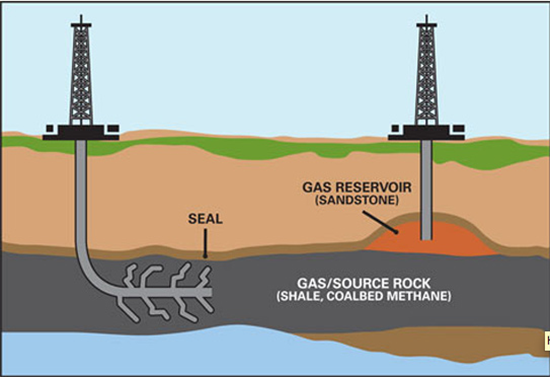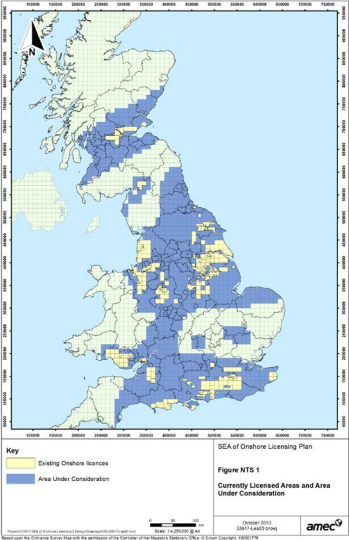Robin Webster
27.01.2014 | 12:00pmConfused about the difference between conventional and unconventional gas? Can’t tell your resources from your reserves? Here’s Carbon Brief’s guide to the key terms in the shale gas debate.
Shale gas: Shale is a sedimentary rock formed from deposits of mud, silt, clay and organic matter. According to the British Geological Survey (BGS), it makes up 35 per cent of the world’s surface rocks – but until recently it wasn’t that easy to extract gas trapped inside it. That’s because shale gas is very fine-grained, so the gas sticks to the rock.
Fracking: The process of hydraulic fracturing involves pumping a fluid made of water mixed with chemicals at high pressure into a well that has been drilled. The fluid creates fractures in the rock, making it possible to get the gas out. Fracking has been used in the oil industry since the mid-nineteenth century – but only applied to shale gas extraction in the last couple of decades.
A representative diagram of the fracking process. Source: SciTech Daily website.
Shale oil: Shale gas isn’t the only fossil fuel that can be extracted from shale rock. And there’s quite a bit of it under the ground: the US Energy Information Administration estimates that shale oil represents 10 per cent of the world’s crude oil resources.
Tight oil: Shale oil is a form of tight oil. That’s oil trapped in the densest rocks like sandstone, limestone or sandstone, which is therefore hard to extract. Tight oil has only been extracted commercially for a few years, but it’s expected to make up a significant share of the world’s oil supplies in the future. The US’s tight oil production is likely to make it the world’s top oil producer by 2015, according to the International Energy Agency.
We don’t yet know how much shale oil there is in the UK. BGS is working on a survey of the shale oil resource in south England, due out in March or April this year.
Unconventional oil and gas: Shale oil and shale gas are examples of ‘unconventional’ energy sources because they have only recently become accessible using new extraction techniques. Some commentators have suggested other forms of conventional energy forms, particularly oil, could run out. But the ability to access unconventional sources of energy has transformed the energy landscape, according to the International Energy Agency – and mean the world will have access to ” ample” amounts of energy over the next two decades despite rising demand, according to energy giant BP.
Shale gas resource and reserves: Shale gas resource refers to the amount of shale gas present in the ground – while reserves means the amount that it will be possible to get out. Media headlines about the UK shale gas industry have often confused the two terms. A headline in the Times, for example, suggested the UK has “enough shale gas to heat every home for 1,500 years”.
BGS says the north of England has a shale gas resource of 1300 trillion cubic feet of gas – but it may only be possible to extract ten per cent, or even less. This could be equivalent to about 40 years of the UK’s current gas supply, which is still pretty significant.
The 14th round of onshore oil and gas licences: Energy company interest in UK shale gas is increasing. Just recently, French oil and gas company Total announced plans to invest £35 million in UK shale gas.
A company wanting to extract shale gas in the UK needs a licence. The government invites companies to apply for licences through a series of competitions, known as licensing rounds. The 14th licensing round, recently released, proposes that companies can apply for licences in the areas below:
The map doesn’t mean that companies will apply for licences all over the country, however. This is partly because geologists don’t think there’s oil and gas in all the blue areas on the map. While some licenses might be handed out to drill in London, for example, there’s currently no evidence to suggest there’s any shale oil or gas there.
Exploration well: Once a company has obtained a licence, it has to go through a complicated process of applying for planning permission to drill an exploratory well. The process involves making nine different applications for permits from the Environment Agency (EA), relating for example to risks to groundwater, surface water pollution and water abstraction.
Exploration wells help companies work out whether there is any oil and gas in the ground, and whether it’s worth trying to get it out. Only then will they consider whether it’s worth pressing ahead with fracking.
In the UK, the industry still hasn’t developed that far. So far, a few companies are exploring for shale gas and just one company has tried fracking. The EA, meanwhile, has only got as far as developing regulations for shale gas exploration in this country. It hasn’t produced any work on the rules governing large-scale commercial extraction of shale gas yet. That could all change soon – but it will take a few years, at the very least.



